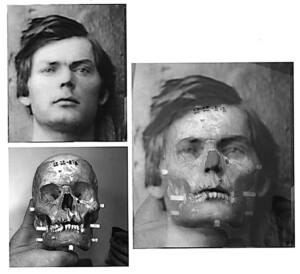The Relationship Between Facial Recognition and Reconstruction
 Facial recognition and facial reconstruction are both very important to forensics. Both have a unique role when investigating a crime.
Facial recognition and facial reconstruction are both very important to forensics. Both have a unique role when investigating a crime.
Facial recognition is used to try to positively identify a suspect. This can be done through an eyewitness or if there is a picture technology can be used . This technology is facial recognition software that uses specific points on an image and then compares those points to the same points of images that are in a database.
Facial reconstruction is used to try to positively identify the victim. This can either be done by three dimensional reconstruction, which uses tissue markers and clay to form an approximate reconstruction, or two dimensional reconstruction that uses photography and sketching to try create an approximate reconstruction.
Facial Recognition and Facial Reconstruction connect with each other because although facial recognition programs are used to try to positively identify a suspect and facial reconstruction is used in order to try to positively identify the victim. Both of these are working to the same goal, to try to identify the unknown. And they do this by using points on the face to help guide them so that the image can hopefully be matched or so that the sculptor can make the reconstruction as accurate as possible. If one looks at it facial reconstruction is just another form of facial recognition.
3D forensic facial reconstruction is the art of reconstructing what a face might have looked like from a skull. This technique is most often used on discovered skeletal remains where the identity of the victim is unknown; it is a last resort for when all other modes of identification have failed to provide the victim’s identity. 3D facial reconstruction is not a legally recognized technique for positive identification and is not admissible in court as expert testimony.
Facial reconstruction starts with assessing the owner of the skull’s race, sex, and age. The race and sex can be determined with relatively good accuracy from the skull alone and certain age groups can be very loosely approximated from the skull as well. The process of reconstruction starts with making a mold of the unknown skull with the jaw attached and false eyes in place. Depth markers are placed on 21 different “landmark” areas of the mold of the skull to approximate the facial tissue thickness that lay on the skull. These tissue thicknesses are approximated from averages of other people of the same age, sex, and race as the skull is assumed to be. Facial muscles are placed on the mold next and then the face is built up with clay to within a millimeter of the depth markers as tissue. The nose and eye setting are very difficult to estimate due to the enormous amount of variation possible, mathematical models are used to make the approximations, the mouth is assumed to be the same width as the distance between the pupils. In facial reconstruction the eyes, nose, and mouth are mostly guess work. Characteristics such as birthmarks, wrinkles, weight, scars, and such are guesses at best and cannot actually be determined from the skull.
No single methodology has been established for 3D forensic facial reconstruction so there are a number of different methods, in the end facial reconstruction is a scientifically based artist’s rendition of what a face might have looked like. 3D facial reconstruction is considered to be inherently inaccurate and different artists, given the same skull, will always come back with different looking faces.
Back to Forensic Investigation
Back to Crime Library
|
|
|

